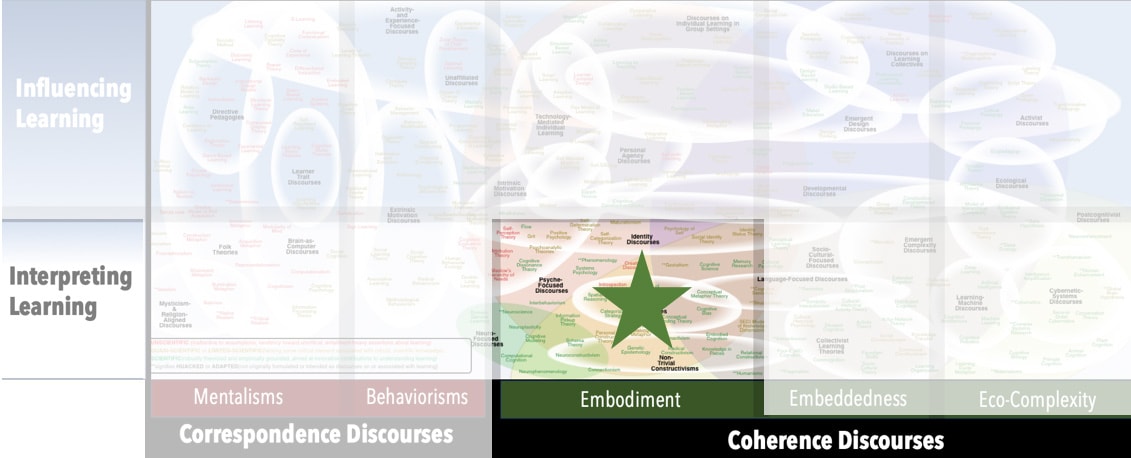AKA
Cognitive Conflict
Cognitive Disequilibrium
Dissonance Reduction Theory
Focus
Mental discomfort when faced with contradictory informationPrincipal Metaphors
- Knowledge is … coherent set of beliefs and values
- Knowing is … comfort with beliefs and values
- Learner is … discomfort avoider (brain or individual)
- Learning is … adapting beliefs and values (to alleviate discomfort)
- Teaching is … provoking and managing cognitive discomfort
Originated
1950sSynopsis
Cognitive Dissonance Theory addresses the mental discomfort one feels when one’s beliefs, ideas, or values are inconsistent or contradictory. Discomfort or psychological dissonance is triggered when new evidence does not align with previously held notions. To ameliorate discomfort, people either adjust to, argue against, or remain indifferent to the contradiction:- Dissonance Reduction – the strategies or processes one uses to reduce the mental unease prompted by inconsistencies among aspects of one’s cognitive system. Examples include:
- Bolstering of an Attitude – generating new behaviors and/or thoughts that are consistent with an attitude after inconsistencies with that attitude are noticed
- Forced Compliance Effect (Induced Compliance Effect) – altering an attitude to be more consistent with a behavior after the two are recognized to be inconsistent
- Cognitive Consonance – whenever multiple elements of conscious experience are sufficiently coherent that no unease is triggered
- Cognitive Friction – a specific sort of Cognitive Dissonance that occurs when the effects of one’s deliberate actions are different from what one might expect. Cognitive Friction is most often associated with digital technologies, and it is typically expressed as frustration and dissatisfaction.
- Cognitive Consistency Theory – any theory that positions a need or desire to maintain coherence among elements of a cognitive system is a key motivator for learning or action
- Balance Theory (Cognitive Balance Theory) (Fritz Heider, 1940s) – the perspective that people like to feel balanced and are motivated to restore balance if feeling unbalanced mental, physiological, social, and other domains
- Congruity Theory (Charles Osgood & Percy Tannenbaum, 1970s) – focused on communications, the perspective that people desire congruity (consistency) between their impressions of the content and the source of a message – and so, are motived to revise one or both to restore contruity
- Self-Consistency Perspective of Cognitive Dissonance Theory (Elliot Aronson, 1970s) – a variation of Cognitive Dissonance Theory that focuses on the manner in which one must resolve the inconsistency that triggers a mental discomfort. This perspective asserts that specific inconsistency must be resolved.
- New-Look Theory (Joel Cooper, Russell Fazio, 1980s) – a perspective on cognitive dissonance that suggests it is not the product of opposing or incommensurable thoughts, but rooted in unexpected and undesired consequences to one’s actions
- Self-Affirmation Theory (Claude Steele, 1980s) – a theory that suggests a strategy for reducing discomfort with challenges to self-view is to directly resolve an inconsistency, affirming a different aspect of self, or both.
- Control Theory (Charles Carver & Michael Scheier, 1980s) – the suggestion that one regulates one’s activity through iterative cycles of comparing to a standard, identifying discrepancies, and reducing those discrepancies. (Note: This version of Control Theory comes out of psychology, and it should not be confused with Control Theories out of Sociology. See Personal Agency Discourses.)
- Structured Design for Attitudinal Instruction (Thomas Kamradt, Elizabeth Kamradt, 1990s) – a model of teaching concerned with deliberately introducing dissonance as the means support learning across affective, cognitive, and psychomotor domains
- Action-Based Model (Eddie Harmon-Jones, 2000s) – a variation of Cognitive Dissonance Theory that focuses on cognitive events that have implications for action. When there is dissonance among such events, acting becomes difficult.
- Self-Standards Model (Jeff Stone, Joel Cooper, 2000s) – a variation of Cognitive Dissonance Theory that focuses on the different ways to assess self-esteem, suggesting that the level and sort of dissonance that is experienced depend on whether actions are assessed against personal standards or a normative standard
Commentary
Critiques of Cognitive Dissonance Theory tend to be focused on methodological issues related to experimental design, operationalization, and/or measurement. Cognitive Dissonance Theory is often used for analyzing consumer behavior and for marketing strategy. The notion is sometimes critiqued as an uncritical modernization of:- Aporia – a Greek word having to do with puzzlement, being perplexed, at an impasse, or raising doubts, in the context of teaching, Aporia typically refers to modes of engagement that prompt the learner to question assumptions and conclusions.
- Socratic Method – a form of dialogue/argument in which one participant asks strategic questions in an attempt to draw out the other’s assumptions and ideas, aiming to reveal inconsistencies, gaps, and/or contradictions
Authors and/or Prominent Influences
Leon FestingerStatus as a Theory of Learning
Cognitive Dissonance Theory is a theory of learning.Status as a Theory of Teaching
Cognitive Dissonance Theory is not a theory of teaching, but it has immediate, practical advice for teachers.Status as a Scientific Theory
Cognitive Dissonance Theory is supported by studies and mappings from Neuroscience, which confirm there is a neural basis for the theory. As well, research meta-analyses indicate that invoking Cognitive Dissonance Theory can be used effectively to affect students’ reading and science skills.Subdiscourses:
- Action-Based Model
- Aporia
- Balance Theory (Cognitive Balance Theory)
- Bolstering of an Attitude
- Cognitive Consistency Theory
- Cognitive Consonance
- Cognitive Friction
- Congruity Theory
- Control Theory (in Psychology)
- Dissonance Reduction
- Forced Compliance Effect (Induced Compliance Effect)
- New-Look Theory
- Self-Affirmation Theory
- Self-Consistency Perspective of Cognitive Dissonance Theory
- Self-Standards Model
- Structured Design for Attitudinal Instruction
Map Location

Please cite this article as:
Davis, B., & Francis, K. (2023). “Cognitive Dissonance Theory” in Discourses on Learning in Education. https://learningdiscourses.com.
⇦ Back to Map
⇦ Back to List
